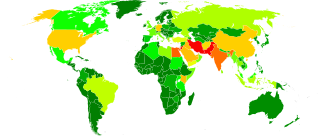
The National Security Agency (NSA) is a national-level intelligence agency of the United States Department of Defense, under the authority of the Director of National Intelligence (DNI). The NSA is responsible for global monitoring, collection, and processing of information and data for foreign and domestic intelligence and counterintelligence purposes, specializing in a discipline known as signals intelligence (SIGINT). The NSA is also tasked with the protection of U.S. communications networks and information systems. The NSA relies on a variety of measures to accomplish its mission, the majority of which are clandestine. The existence of the NSA was not revealed until 1975. The NSA has roughly 32,000 employees.

Ashkan Soltani is the executive director of the California Privacy Protection Agency. He has previously been the Chief Technologist of the Federal Trade Commission and an independent privacy and security researcher based in Washington, DC.

PRISM is a code name for a program under which the United States National Security Agency (NSA) collects internet communications from various U.S. internet companies. The program is also known by the SIGAD US-984XN. PRISM collects stored internet communications based on demands made to internet companies such as Google LLC under Section 702 of the FISA Amendments Act of 2008 to turn over any data that match court-approved search terms. Among other things, the NSA can use these PRISM requests to target communications that were encrypted when they traveled across the internet backbone, to focus on stored data that telecommunication filtering systems discarded earlier, and to get data that is easier to handle.

Edward Joseph Snowden is an American and naturalized Russian former computer intelligence consultant and whistleblower who leaked highly classified information from the National Security Agency (NSA) in 2013, when he was an employee and subcontractor. His disclosures revealed numerous global surveillance programs, many run by the NSA and the Five Eyes intelligence alliance with the cooperation of telecommunication companies and European governments and prompted a cultural discussion about national security and individual privacy.

Tempora is the codeword for a formerly-secret computer system that is used by the British Government Communications Headquarters (GCHQ). This system is used to buffer most Internet communications that are extracted from fibre-optic cables, so these can be processed and searched at a later time. It was tested from 2008 and became operational in late 2011.
Special Source Operations (SSO) is a division in the US National Security Agency (NSA) which is responsible for all programs aimed at collecting data from major fiber-optic cables and switches, both inside the US and abroad, and also through corporate partnerships. Its existence was revealed through documents provided by Edward Snowden to media outlets in 2013 and, according to him, it is the "crown jewel" of the NSA.

BLARNEY is a communications surveillance program of the National Security Agency (NSA) of the United States. It started in 1978, operated under the Foreign Intelligence Surveillance Act and was expanded after the September 11 attacks.

Bullrun is a clandestine, highly classified program to crack encryption of online communications and data, which is run by the United States National Security Agency (NSA). The British Government Communications Headquarters (GCHQ) has a similar program codenamed Edgehill. According to the Bullrun classification guide published by The Guardian, the program uses multiple methods including computer network exploitation, interdiction, industry relationships, collaboration with other intelligence community entities, and advanced mathematical techniques.

OAKSTAR is a secret internet surveillance program of the National Security Agency (NSA) of the United States. It was disclosed in 2013 as part of the leaks by former NSA contractor Edward Snowden.

STORMBREW is a secret internet surveillance program of the National Security Agency (NSA) of the United States. It was disclosed in the summer of 2013 as part of the leaks by former NSA contractor Edward Snowden.

Dishfire is a covert global surveillance collection system and database run by the United States of America's National Security Agency (NSA) and the United Kingdom's Government Communications Headquarters (GCHQ) that collects hundreds of millions of text messages on a daily basis from around the world. A related analytic tool is known as Prefer.

Ongoing news reports in the international media have revealed operational details about the Anglophone cryptographic agencies' global surveillance of both foreign and domestic nationals. The reports mostly emanate from a cache of top secret documents leaked by ex-NSA contractor Edward Snowden, which he obtained whilst working for Booz Allen Hamilton, one of the largest contractors for defense and intelligence in the United States. In addition to a trove of U.S. federal documents, Snowden's cache reportedly contains thousands of Australian, British, Canadian and New Zealand intelligence files that he had accessed via the exclusive "Five Eyes" network. In June 2013, the first of Snowden's documents were published simultaneously by The Washington Post and The Guardian, attracting considerable public attention. The disclosure continued throughout 2013, and a small portion of the estimated full cache of documents was later published by other media outlets worldwide, most notably The New York Times, the Canadian Broadcasting Corporation, the Australian Broadcasting Corporation, Der Spiegel (Germany), O Globo (Brazil), Le Monde (France), L'espresso (Italy), NRC Handelsblad, Dagbladet (Norway), El País (Spain), and Sveriges Television (Sweden).
This is a category of disclosures related to global surveillance.

Global mass surveillance can be defined as the mass surveillance of entire populations across national borders.

Global surveillance refers to the practice of globalized mass surveillance on entire populations across national borders. Although its existence was first revealed in the 1970s and led legislators to attempt to curb domestic spying by the National Security Agency (NSA), it did not receive sustained public attention until the existence of ECHELON was revealed in the 1980s and confirmed in the 1990s. In 2013 it gained substantial worldwide media attention due to the global surveillance disclosure by Edward Snowden.
The Fourth Amendment Protection Acts, are a collection of state legislation aimed at withdrawing state support for bulk data (metadata) collection and ban the use of warrant-less data in state courts. They are proposed nullification laws that, if enacted as law, would prohibit the state governments from co-operating with the National Security Agency, whose mass surveillance efforts are seen as unconstitutional by the proposals' proponents. Specific examples include the Kansas Fourth Amendment Preservation and Protection Act and the Arizona Fourth Amendment Protection Act. The original proposals were made in 2013 and 2014 by legislators in the American states of Utah, Washington, Arizona, Kansas, Missouri, Oklahoma and California. Some of the bills would require a warrant before information could be released, whereas others would forbid state universities from doing NSA research or hosting NSA recruiters, or prevent the provision of services such as water to NSA facilities.

Klayman v. Obama, 957 F.Supp.2d 1, was a decision by the United States District Court for District of Columbia finding that the National Security Agency's (NSA) bulk phone metadata collection program was unconstitutional under the Fourth Amendment. The ruling was later overturned on jurisdictional grounds, leaving the constitutional implications of NSA surveillance unaddressed.

This timeline of global surveillance disclosures from 2013 to the present day is a chronological list of the global surveillance disclosures that began in 2013. The disclosures have been largely instigated by revelations from the former American National Security Agency contractor Edward Snowden.
Optic Nerve is a mass surveillance programme run by the British signals intelligence agency Government Communications Headquarters (GCHQ), with help from the US National Security Agency, that surreptitiously collects private webcam still images from users while they are using a Yahoo! webcam application. As an example of the scale, in one 6-month period, the programme is reported to have collected images from 1.8 million Yahoo! user accounts globally. The programme was first reported on in the media in February 2014, from documents leaked by the former National Security Agency contractor Edward Snowden, but dates back to a prototype started in 2008, and was still active in at least 2012.












